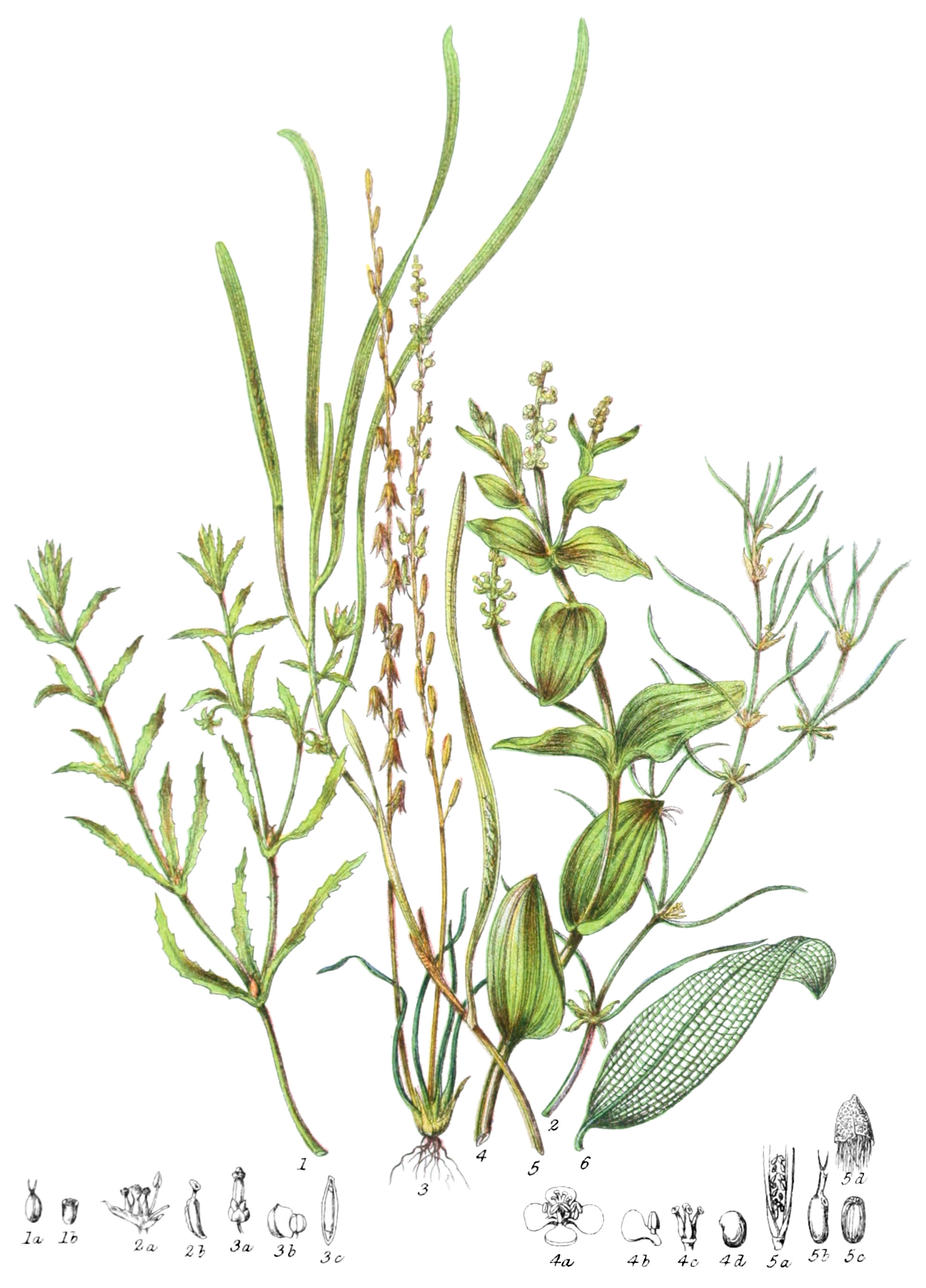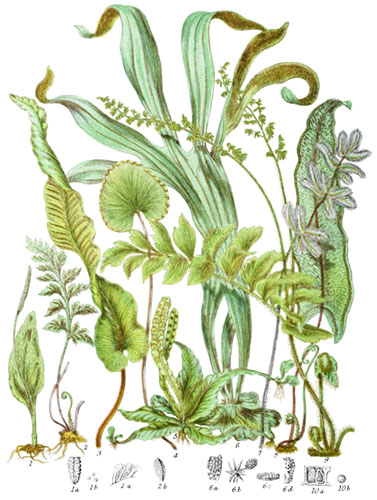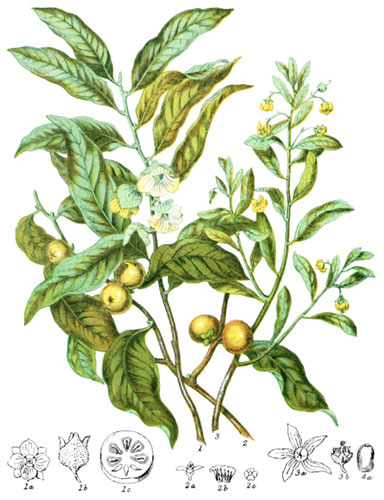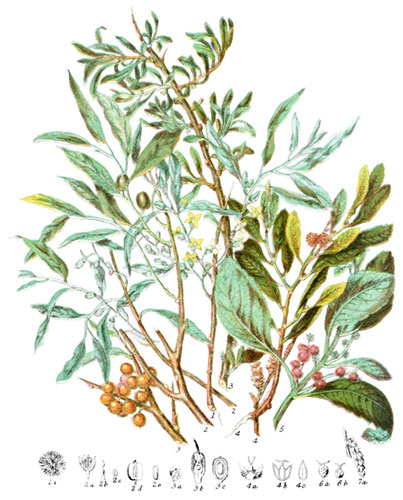Key characteristics
Water-plants inhabiting both fresh and salt water. The leaves are very cellular, with parallel veins, and usually membranous stipules between the leaf-stalks, sometimes sheathing at the base. The flowers are inconspicuous, often arranged in terminal spikes, or within herbaceous spathes: the stamens and pistil are sometimes separate; the corolla is composed of sepals and petals nearly alike, or of scales often falling way; the stamens are of definite number, attached to the base of the ovary, which is single or many, above the calyx; the stigma simple. The fruit is dry, very rarely opening by regular valves, or drupaceous, one-celled, and one-seeded. The seed contains no albumen.
This Tribe has only slight affinity with Juncaceæ.
Scarcely any useful properties exist in these plants.
Select plants in this order
Not all plants listed are illustrated and not all plants illustrated are listed.
- Naias, meaning water-nymph, is selected as the head of a small tribe composed of various aquatic plants of scarcely any beauty of form or colour, and very few useful qualities to man.
- Naias marina (1) was found and described by Petro Michelio, a botanist of Florence, in 1729; it grows plentifully in the canal between Pisa and Leghorn, and is of a thin pellucid substance, like most of these aquatics.
- Zannichellia (2) was so named in memory of a Venetian of the last century. It abounds in mashes in some parts of England, and in many countries of Europe. The single stamen of the flower stands upon a separate stalk by the side of the four or five pistils; the seeds are toothed along the outer edge, and contain each a single seed.
- Zannichellia and Naias are both translucent cellular plants, without either an outer skin or pores, for which reason they rapidly perish when taken out of the water.
- Caullinia is of a similar nature, and exhibits in its transparent stem the circulation of the sap between the joints.
- Triglochin is derived from the Greek, alluding to the three angles of the capsule.
- T. palustre (3) is common in marshes, and is readily distinguished from other plants when in fruit, by the singular form of the seed-vessel. In the highlands of Scotland it is abundant, and is said to afford agreeable food to cattle; probably on account of a salt flavour which prevails in this as well as in other British species, T. maritima. This latter plant is limited to marshy places on the coast, chiefly to the south of our island; the capsules have six angles, and do not acquire the arrow-head shape in ripening.
- T. bulbosum represents the genus at the Cape of Good Hope.
- Potamogetum (4), from the Greek for near a river, betokens the locality of nearly all the species. Some are of the pellucid nature frequent in aquatic plants, brittle when dry, in the air, entirely without hairs or down on the surface. They afford shelter to various small creatures inhabiting water, and food to many.
- P. perfoliatum (4) is common in streams and ditches in most of our counties.
- P. natans, with wide oval leaves, of a tough leathery substance, is a favourite food of the swan: the root is eaten by poor peasants in Siberia.
- P. crispum is eagerly devoured by ducks.
- In the Swiss lakes, Potamogeton abounds, P. serratum and others forming dense masses in the limpid waters.
- Zostera (5) was named from the Greek for riband. It is remarkable that, in the early history of botany, plants were most frequently named from some characteristic in their general appearance; in after times, more generally in memory of some naturalist; in the present day they usually receive the name of the discoverer. Zostera approaches towards the true sea-weeds in form, and mingles with them on the shore when uprooted; but is still in the class of flowering plants, and has a single stamen and two pistils placed alternately on a long membranous sheath, filled with air. The pollen of the anthers is in long fine threads. On the eastern shores, the Sea-wrack is useful in preventing the encroachments of the sea on the sand; as thatch, it is said to be exceedingly durable, becoming bleached by exposure to the air. Horses will eat it, but cows refuse it. Italian flasks are usually wrapped in it, and in poor districts on the coast it is used for stuffing cushions and packing.
- Amphibolis zosteræfolia is brought by the ocean waves to the shores of New Holland, and other species is seed in the West Indies.
- Ouviranda fenestralis (6) is a singular exception to the general composition of a leaf, being destitute of pulpy matter, the netted veins forming the whole substance. It was discovered growing in the water in the Bay of Diego Soavez, in Madagascar, and sent thence to the Jardin des Plantes in Paris; the roots are wholesome.
Locations
This Tribe inhabits marshes and watery places from the North Sea to the Mediterranean. It is found also in the Indian Ocean, on the coasts of Arabia, at the Cape of Good Hope, in Tropical America, and in Australia.
Legend
- Naias marina, Water-weed. South Europe.
- Ovary.
- Section.
- Zannichellia palustris, Horned Pond-weed. Ponds, England.
- Flower.
- Ovary.
- Triglochin palustre, Marsh Arrow-grass. Marshes, England.
- Flower.
- Petal and Stamen.
- Section of Ovary.
- Potamogeton perfoliatum, Perfoliate Pond-weed. Ponds, England.
- Flower, magnified.
- Petal and Stamen.
- Ovaries.
- Seed.
- Zostera marina, Sea Wrack-grass. Shores, England.
- Section of Sheath.
- Ovary.
- Seed.
- Anther and Pollen.
- Ouviranda fenestralis. Madagascar.
Explore more
Posters
Decorate your walls with colorful detailed posters based on Elizabeth Twining’s beautiful two-volume set from 1868.
Puzzles
Challenge yourself or someone else to assemble a puzzle of all 160 botanical illustrations.





